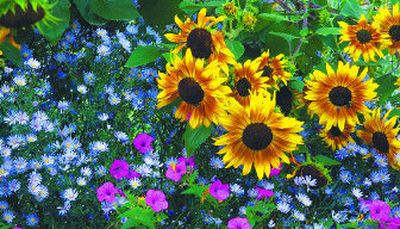New book targets Western gardens

Just in time for the next gardening season, Sunset Books will release the eighth edition of the Sunset Western Garden Book later this week at the Northwest Flower and Garden Show. It has been the go-to reference for western gardeners for more than 70 years.
The Sunset Western Garden Book works so well for our region because it is written for western gardens and is not a one-size-fits-all general reference aimed at the whole country. We have very different gardens here that are wet and cool in the winter and dry in the summer, opposite that of the rest of the country.
The mainstays of the book are its unique plant selection guides and an encyclopedia of over 8,000 plants all tied to Sunset’s unique climate zone system.
The plant selection guide lists plants that can be used in different landscape situations or special uses like plants that attract birds and butterflies, love shade or dry places or work well in small spaces. “We see gardens getting smaller, we see people more pressed for time. They want a garden that isn’t going to take a whole lot of time to take care of,” says Kathleen Brenzel, longtime editor of the book.
Editors added 500 plants and numerous varieties to original encyclopedia listings of over 8,000 plants to reflect the many new plant introductions since 2001. Each listing gives detailed growing information and notes on special requirements the plant may need. All the information is tailored to the western garden.
Some changes were made to the climate zone maps for the Inland Northwest particularly near British Columbia’s Lake Okanagan and the Kootenai River Valley north of Bonners Ferry to Kootenay Lake in British Columbia. Both were moved from Sunset Zone 2A to 2B, a little warmer. Brenzel attributed the change to more accurate information from Environment Canada’s weather data.
Sunset’s unique climate zone system is very different from the more universal USDA system. While the USDA system is based on average minimum winter temperatures, Sunset’s also take into account several other factors including latitude, altitude, the influence of marine and/or continental air masses, regional and local topography, known microclimates and soil types. They tend to reflect the growing conditions we face here a little more realistically than the USDA system. Sunset’s climate zones get you into the ballpark of understanding your garden, says Brenzel. Understanding your microclimates and applying the book’s information will get you to home base in gardening. The Sunset system puts the Inland Northwest mostly in its zones 1A, 2A and 2B while the USDA zones are Zones 4 to 6.
The book is rounded out with essays or Postcards written by the some of the West’s most respected horticulturists. “We talked to horticulturists all around the West to get their take on the best varieties and tips,” said Brenzel. At the back of the book is a practical gardening guide with topics listed alphabetically for easy quick reference.